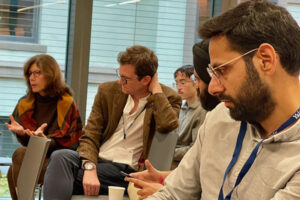In a recent paper, Goldberg and a co-author find that population size, trade, and inequality are important factors in today’s changing global economy.
Access to foreign markets has been a key driver of economic development and poverty alleviation in several low-income countries. But amid rising protectionism and economic nationalism globally, is the export-led growth model no longer viable? More broadly, how important are global markets for growth and poverty reduction?
In her Presidential Address to the Econometric Society titled “Demand-Side Constraints in Development. The Role of Market Size, Trade, and (In)Equality” and recently published by Econometrica, Pinelopi (Penny) Koujianou Goldberg – the Elihu Professor of Economics and Global Affairs at Yale and an affiliate of Yale’s Economic Growth Center (EGC) – and her co-author Tristan Reed shed new light on these questions.
Goldberg served as Chief Economist of the World Bank Group from 2018 to 2020 and as President of the Econometric Society in 2021. Her recent research focuses on the interactions between trade, poverty, and inequality. The Unequal Effects of Globalization, a monograph adapted from her Ohlin Lecture at the Stockholm School of Economics in 2019, was published by MIT Press in August 2023.
In their recent paper, Goldberg and Reed use a novel empirical approach to find that the size of the market to which a country has access matters greatly for sustained poverty reduction. Market size, in turn, depends on a country’s own domestic population, access to foreign markets, and level of equality.
Penny recently spoke with me to discuss the paper’s approach and key findings, as well as its broader implications for our rapidly evolving global economy.
Your paper focuses on the relationships between population size, trade agreements, inequality, and poverty reduction. What was your motivation for this particular focus?
Tristan Reed and I started working on this project while I was at the World Bank. This was in 2019, when the US had just imposed tariffs against China – China had retaliated, and it seemed like we were entering a period of rising protectionism and economic nationalism. That turned out to be the beginning of a big policy reversal that, in my opinion, marked the end of a long era of globalization. As the World Bank’s chief economist, I started wondering: what would the future look like for low-income countries in a world with much more protectionism and economic nationalism? More broadly, what’s the new vision and model for economic development and poverty reduction?
Up to that point, how would you characterize trade’s role in the development process?
Many economists associate the fast growth of developing countries in recent decades, especially in Asia, with participation in trade. Essentially, trade gave these countries access to large and lucrative foreign export markets, while their lower labor costs gave them a comparative advantage in labor-intensive manufacturing industries. This set off a virtuous cycle, where increased export revenues got invested in human capital and new technologies, while technology transfer, “learning by exporting and importing,” and the foreign direct investments accompanying trade enhanced productivity. The so-called “East Asian tigers” are good case studies of how this process unfolded, and more recently, Vietnam has seen rapid transformation and poverty reduction since it liberalized trade in 2001.
Today, there are concerns that such export-led growth may not be an option for low-income countries in the future – for at least three reasons. The first is technology, with increased automation and the advent of AI. While it’s not yet clear how these factors will play out, there are good reasons to believe that technology will weaken low-income countries’ comparative advantage in low-skill, labor-intensive industries. The second reason is political: high-income countries simply have much less appetite for importing products or services if these imports are perceived as coming at the expense of domestic workers. The third reason emerged more recently: many countries just have different priorities today, from climate change to national security. While these objectives are certainly worthwhile, the change in priorities has important implications for trade and the role that trade plays in the development process.
How did you decide to focus on the role of market size and equality in development?
A large part of the development literature has focused on what we call “supply-side constraints” to the development process. Our focus on market size, by contrast, puts the emphasis on “demand-side constraints.” Consider human capital: while everyone agrees that improving education is worthwhile, the demand for educated people and skilled workers – in terms of jobs and sectors of the economy that can absorb them – is also critically important. This demand is often taken for granted. Our focus on market size seeks to analyze these demand-side concerns. Our belief is that in recent years, it is the demand-side constraints that have become binding.
A key part of our argument is that countries need a certain level of equality to develop and reduce poverty, since the benefits of growth need to trickle down to enough people in order to create additional demand and kickstart the development process.
The emphasis on the demand side also shows why international trade is so important, especially for smaller countries: access to foreign export markets allows countries to effectively increase the size of their market.

What are some examples of how these dynamics can play out in the real world?
India is a good example of why big countries with very large domestic markets may not need to rely on foreign markets to grow and develop. While there is a lot of debate about the exact numbers, there is no question that India has continued growing quite fast even as protectionism and economic nationalism have increased globally. Notably, India’s development model is not based on exports or manufacturing. And with its population of ca. 1.6 billion people, India can largely rely on its own domestic market – especially its growing middle class.
But Nigeria provides a counter-example that demonstrates why inequality is so relevant. Despite being both large and very rich in natural resources, Nigeria is still plagued by high poverty – and like many African economies, Nigeria is extremely unequal. Since wealth is held in the hands of the few, who primarily spend it on luxury goods and consumption services (e.g., expensive houses, luxury cars, drivers, household staff), the benefits of Nigeria’s growth have not trickled down to create a large middle class and have not translated into sustainable economic growth or poverty reduction. Nigeria also has very high levels of urban poverty, as millions have moved into cities that lack jobs or sectors to absorb them – a phenomenon economists have labeled “urbanization without industrialization.”
If you’re a tiny country, on the other hand, then it’s a very different story. In low-income countries with very small populations, there is simply no way to grow and reduce poverty without connecting to the rest of the world. And here, the purchasing power of trading partners is very important: the most promising way for small, low-income countries to grow rapidly is by connecting to rich countries through export markets. But as noted, that model of development is becoming increasingly challenging to pursue.
This is all quite intuitive, of course, and these are not new ideas. But we thought, how might we bring this to the data in a more systematic way?
Your paper utilizes a fairly novel empirical approach. Can you explain?
Our starting point is the idea that development entails the adoption of an increasing-returns- to-scale technology by imperfectly competitive firms that need to pay the fixed setup cost of switching to that technology. Our framework combines a model of a dual economy and structural transformation with a different strand of the economics literature – an industrial organization model that estimates “entry thresholds,” or how big a market needs to be in the presence of scale economies and imperfect competition for at least one firm to enter, as a function of fixed costs and variable profits. Combining these approaches allows us to ask: what is the threshold market size for a low-income country to achieve sustained growth and poverty reduction through structural transformation?
We model market size as a function of a country’s domestic market and its international market. For domestic market, we look at population size and purchasing power, as measured by the relative size of a country’s middle class. For international market, we look at the country’s number of signed trade agreements, using a new database put together by the World Bank, as well as the average GDP per capita of those trading partners.
Using this approach, we analyze country-level data on poverty reduction going back to 1980, focusing on periods of sustained poverty reduction (five or more consecutive years). Based on this data, we estimate that the threshold market size for a low-income country to achieve sustained poverty reduction is 325 million people – a huge number, and much larger than the average low- or lower-middle-income country’s market size.
We also find that the relative size of a country’s middle class is very important for poverty reduction.
What are some of the implications of these findings, given today’s challenging context for trade and international integration?
First and foremost, this project underscores how important international integration is for poverty reduction. In today’s context, that raises a number of challenges for low-income countries. High-income countries, for example, are increasingly focused on “friendshoring” their trade relationships due to concerns about national security, geopolitics, or factors like environmental and labor standards. These concerns are important, of course. But if high-income countries only trade with other high-income countries, poverty reduction will be significantly more challenging in low-income countries. This is especially true in a world where a large number of low-income countries are competing for trade relationships with a limited number of high-income countries.
In terms of domestic policies, our analysis strongly suggests that efforts to bring more people into the middle class can be very helpful. In our framework, a more equal distribution of firm profits and wealth play an important role. Accordingly, efforts to assist households in accumulating equity shares as well as land reforms may be worthwhile redistribution policies in countries characterized by large inequalities.
More broadly, our paper points to the need for more targeted research into the drivers of economic development and poverty reduction in our changing geopolitical and economic landscape. This is especially relevant today, with high-income countries increasingly focused on industrial policy – yet with very little attention on whether industrial policy is worthwhile for developing countries. If export-led growth becomes elusive for low-income countries, especially small ones, then much more focus is needed on finding viable alternatives for sustainable growth and poverty reduction.
This article was originally published by the Economic Growth Center.
